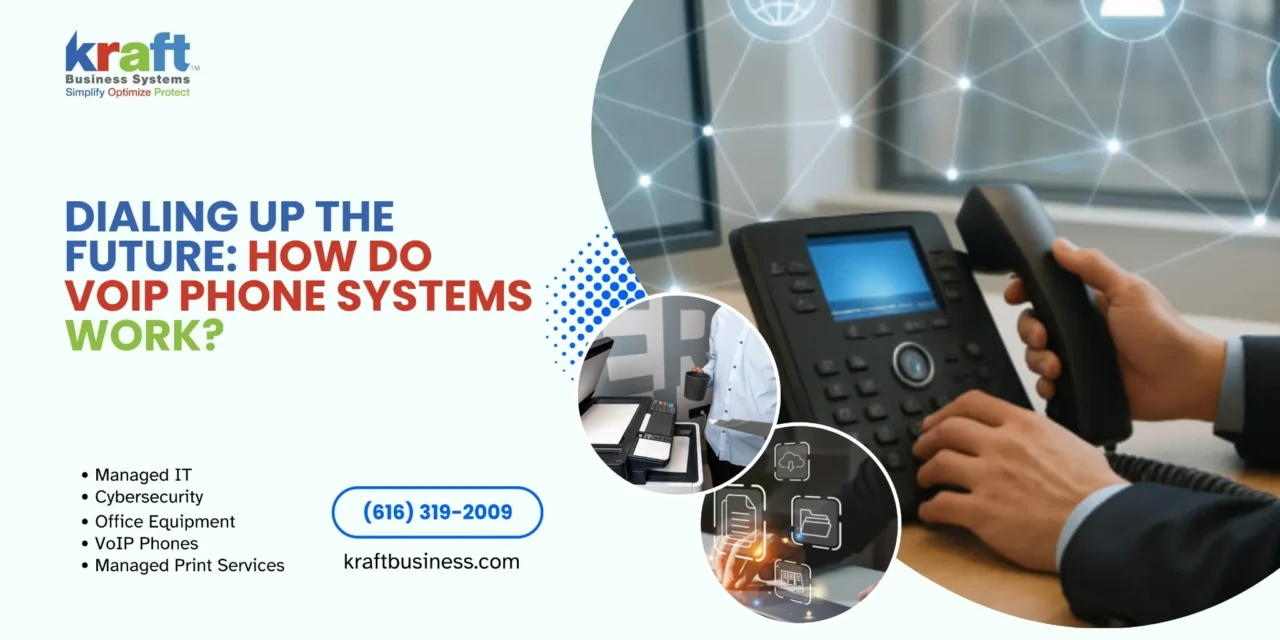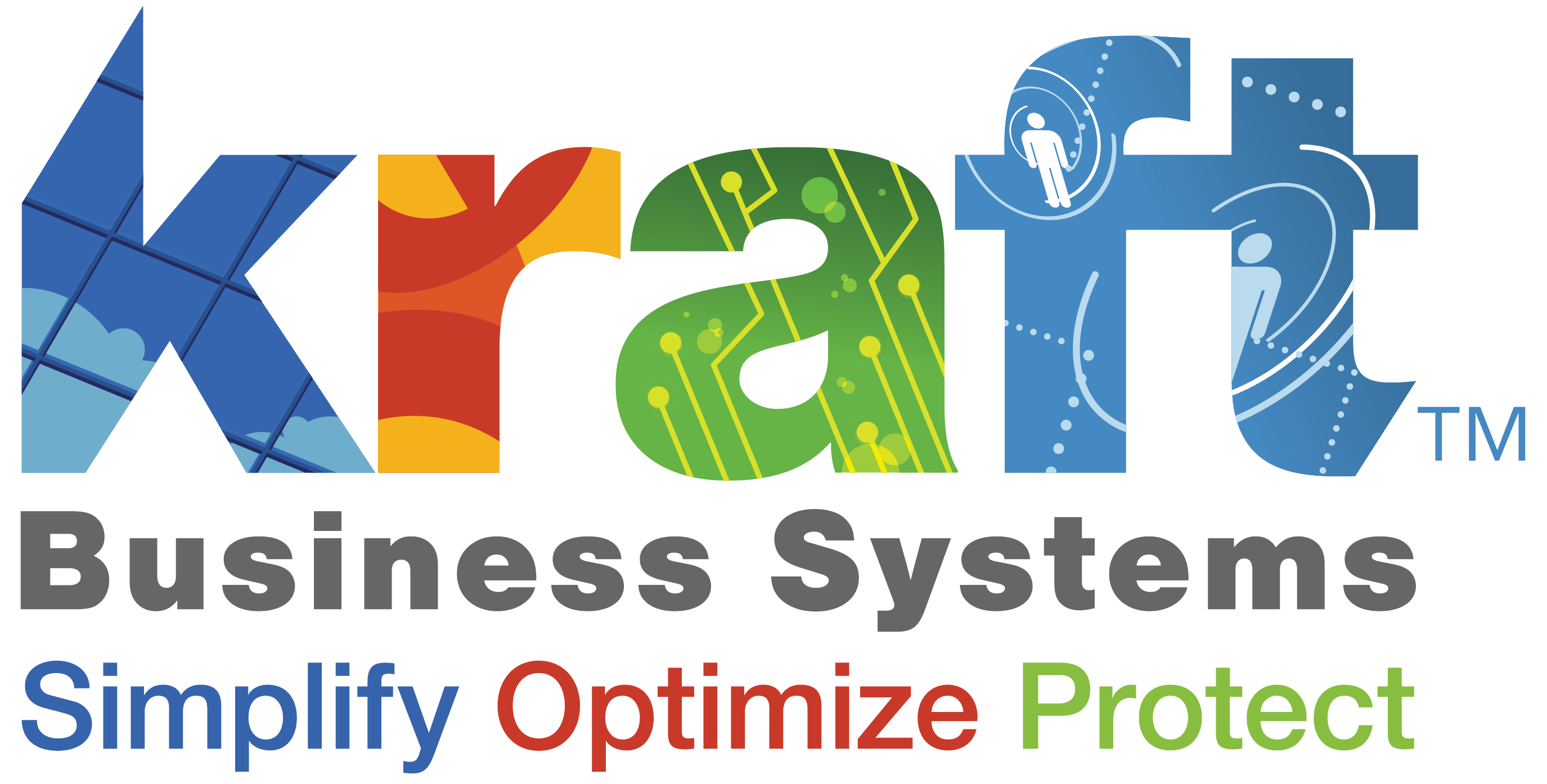How do VoIP phone systems work? VoIP (Voice over Internet Protocol) phone systems convert your voice into digital data packets and send them over the internet instead of traditional phone lines. Here’s the basic process:
- Voice Conversion – Your voice gets converted from analog sound waves to digital data
- Packetization – The digital voice data is broken into small packets
- Internet Transmission – Packets travel over your internet connection to the recipient
- Reassembly – The packets are reassembled and converted back to voice at the destination
- Call Completion – The person receives crystal-clear audio through their phone or device
Gone are the days of tangled cords and sky-high phone bills. VoIP technology transforms how businesses communicate by using your existing internet connection to handle all your voice calls.
Traditional phone systems rely on copper wires and expensive hardware. VoIP systems use the same internet connection you already have for email and web browsing. This means you can make calls from desk phones, computers, smartphones, or tablets – all using the same phone number.
The technology works so well that businesses save up to 50% on their monthly phone bills while gaining features that would cost thousands with traditional systems. Features like auto-attendants, call forwarding, voicemail-to-email, and video conferencing come standard.
VoIP isn’t just about saving money. It’s about future-proofing your business communications. As more countries phase out their old copper wire networks, VoIP becomes the only option for reliable business phone service.
How Do VoIP Phone Systems Work? Step-by-Step
Ever wonder how do VoIP phone systems work when you pick up the phone and hear that crystal-clear voice on the other end? The entire process happens in milliseconds, but there’s some pretty amazing technology working behind the scenes.
When you speak into your VoIP phone, something magical starts happening immediately. Your voice creates sound waves that get captured by the phone’s microphone. The phone then performs analog-to-digital conversion, turning those sound waves into digital samples at an incredible rate – 8,000 times per second. Think of it like taking thousands of tiny snapshots of your voice every second.
Next comes packet switching – the real genius of VoIP technology. Instead of keeping a dedicated phone line open like old-fashioned systems, VoIP breaks your voice into small digital packets. Each packet is like a tiny envelope containing a piece of your conversation, complete with an address label showing where it needs to go.
The Session Initiation Protocol (SIP) handles what we call SIP signaling – basically the “handshake” between your phone and the person you’re calling. SIP finds the recipient, sets up the call parameters, and keeps everything running smoothly throughout your conversation. It’s like having a really efficient operator connecting your call.
Once your call is connected, Real-time Transport Protocol (RTP) streams carry your actual voice data across the internet. These streams use special codecs to compress your voice while keeping it sounding great. G.711 gives you excellent quality but needs more bandwidth, while G.729 squeezes the data smaller to save bandwidth – kind of like choosing between high-definition and standard video quality.
Quality of Service (QoS) settings make sure your voice packets get VIP treatment on your network. Without QoS, your calls might sound choppy when someone else is downloading large files or streaming videos. Each call typically needs about 100 Kbps of bandwidth for optimal quality – that’s less than most streaming music services use.
Modern cloud PBX systems handle all the complex routing and processing in professional data centers. This means you don’t need expensive hardware cluttering up your office. Adding new phone lines becomes as easy as a few clicks in your admin panel.
VoIP Phones for Business systems integrate beautifully with your existing network, making the switch from traditional phones surprisingly painless.
Behind the Scenes: how do voip phone systems work packet flow
The packet flow process is where the real engineering magic happens. Voice sampling continues throughout your entire call, with your phone constantly creating thousands of digital snapshots of your voice every second.
Packetization takes these voice samples and wraps them up like tiny packages, complete with addressing information, sequence numbers, and timing data. Each packet contains just a small slice of your conversation – usually about 20 to 30 milliseconds of audio. It’s like tearing a letter into pieces, numbering each piece, and mailing them separately.
Routers across the internet act like traffic directors, examining each packet’s destination and sending it along the best available path. Unlike traditional phone calls that reserve a dedicated line, VoIP packets can take completely different routes and still arrive in perfect order. One packet might travel through Chicago while the next goes through Denver.
NAT traversal helps packets steer through firewalls and network address translation devices. Many businesses use private IP addresses internally, so special protocols help VoIP packets find their way through these network boundaries without getting lost.
Jitter buffers at the receiving end act like patient assistants, smoothing out any timing hiccups. The internet isn’t perfectly consistent – some packets might arrive fashionably early while others show up slightly late. Jitter buffers queue up these packets briefly to ensure your voice comes out smooth and natural.
Codecs & Protocols: how do voip phone systems work at the technical layer
The technical foundation of VoIP relies on several protocols working together like a well-orchestrated symphony. SIP (Session Initiation Protocol) acts as the conductor, handling everything from finding users to ending calls gracefully.
TLS (Transport Layer Security) and SRTP (Secure Real-time Transport Protocol) encrypt your calls with the same level of security used by banks for online transactions. Your VoIP calls are actually more secure than traditional phone lines, which can be tapped with simple equipment.
H.323 represents an older but still important protocol suite for multimedia communications. While SIP has become the popular choice, H.323 remains valuable for connecting with legacy systems that haven’t made the switch yet.
Session Border Controllers (SBCs) work like security guards for your VoIP network, deciding which calls can enter or leave your system. They also translate between different codec formats when systems speak different “languages.”
E.164 dialing standards ensure phone numbers work consistently whether you’re calling another VoIP user or someone on a traditional landline. This seamless compatibility means you never have to worry about whether the person you’re calling can receive your call.
VoIP vs. Traditional Landlines
The choice between VoIP and traditional landlines isn’t just about picking a phone system – it’s about choosing how your business will communicate for the next decade. How do VoIP phone systems work compared to old-fashioned landlines? The differences are striking.
Traditional PSTN (Public Switched Telephone Network) systems rely on copper lines that were installed decades ago. These systems use circuit switching, which means they reserve an entire communication path for your call’s duration – even when nobody’s talking. It’s like having a dedicated highway lane just for your conversation, whether you’re using it or not.
VoIP takes a completely different approach. Instead of copper wires, your voice travels as digital packets over the internet. This packet switching technology is incredibly efficient – your voice data shares the same network with emails, web browsing, and file transfers.
| Feature | VoIP Systems | Traditional Landlines |
|---|---|---|
| Technology | Digital packets over internet | Analog signals over copper wires |
| Audio Quality | HD audio (twice the quality) | Standard toll quality |
| Cost Savings | Up to 50% reduction | Higher monthly fees |
| International Rates | Up to 90% cheaper | Expensive per-minute charges |
| Features | Auto-attendant, voicemail-to-email, video calling included | Basic features cost extra |
| Scalability | Add lines instantly | Requires technician visits |
| Mobility | Use any device, anywhere | Tied to physical location |
| Maintenance | Minimal, handled by provider | Expensive on-site service calls |
The audio quality difference is immediately noticeable. VoIP systems deliver HD audio quality that’s twice as clear as traditional phones. You’ll hear every word crisply, without the static and interference that plague copper wire systems.
Cost savings represent one of the biggest advantages. Businesses typically see up to 50% reduction in their monthly phone bills after switching to VoIP. International calls that cost over a dollar per minute on landlines might cost just pennies with VoIP systems.
The feature parity between systems heavily favors VoIP. Traditional phone systems charge extra for basic features like call forwarding, voicemail, and conference calling. VoIP systems include these features as standard, along with advanced capabilities like auto-attendants, voicemail-to-email, and video conferencing.
Here’s something that might surprise you: several countries have already shut down their PSTN networks entirely. The Netherlands, Sweden, and Germany have completed their transitions to digital communications. Australia, the UK, and New Zealand plan to switch off their copper networks by 2030.
This global trend makes VoIP not just a cost-saving measure, but a necessity for future business operations. Traditional landlines are becoming obsolete technology, like fax machines or dial-up internet.
IP PBX and SIP Trunking solutions help businesses transition gradually, allowing them to keep existing equipment while adding VoIP capabilities. This approach reduces the stress of changing systems overnight.
Why Businesses Are Switching
The shift to VoIP reflects how work itself has changed. Remote work has made mobility essential – employees need their business phone to work whether they’re in the office, at home, or traveling to client meetings.
Traditional phone systems tie you to a physical location. Miss an important call because you stepped away from your desk? Too bad. VoIP systems let you answer your business line on any device, anywhere with internet access.
Number porting eliminates one of the biggest concerns about switching phone systems. You can keep your existing phone numbers when moving to VoIP. The process typically takes 2-4 weeks, with temporary numbers provided during the transition. Your customers won’t notice any difference except better call quality.
Power over Ethernet (PoE) technology makes installation surprisingly simple. Modern VoIP phones receive both power and data through a single network cable. No more hunting for power outlets or dealing with adapter cables cluttering your desk.
The scalability advantages become obvious as your business grows. Adding a new employee with traditional phones means scheduling a technician visit, running new lines, and waiting days or weeks for installation. VoIP systems let you add new lines in minutes through your online portal.
Hot-desking capabilities support flexible work arrangements. Employees can log into any VoIP phone and instantly access their personal settings, voicemail, and call routing. This flexibility is impossible with traditional phone systems where each extension is tied to specific hardware.
The Business Owner’s Guide to Voice Over Internet Protocol explains how VoIP adapts to modern business practices while providing enterprise-grade features at small business prices. The technology that once required expensive hardware and dedicated IT staff is now accessible to businesses of any size.
Setting Up & Scaling Your VoIP System
Getting your VoIP system up and running doesn’t have to be complicated. Think of it like setting up a really smart network where everything talks to everything else – but instead of just sharing files, you’re sharing crystal-clear conversations.
The beauty of understanding how do VoIP phone systems work becomes clear during setup. Unlike traditional phone systems that require separate wiring for each phone line, VoIP uses your existing network infrastructure. Your business-grade modem connects to a router capable of handling VoIP traffic, which then connects to managed switches that power and connect all your phones.
Don’t worry if you have existing analog phones or that trusty old fax machine. Analog Telephone Adapters (ATAs) act like translators, converting your old equipment’s analog signals into digital packets. This means you can keep using equipment that still works perfectly while gaining all the benefits of VoIP technology.
Softphones and mobile apps give your team incredible flexibility. Your employees can answer their business phone from their laptop during a work-from-home day or from their smartphone while traveling. Same phone number, same professional features – just different devices.
Bandwidth planning prevents those awkward moments when calls sound like robots talking underwater. Each call needs about 100 Kbps of bandwidth – roughly the same as loading a typical webpage. A busy office with 10 simultaneous calls needs at least 1 Mbps dedicated to voice traffic, plus some extra headroom for busy periods.
QoS settings act like a VIP pass for your voice traffic. When someone starts downloading a massive file, QoS ensures your phone calls still get priority treatment. UPS backup systems keep your network equipment powered during outages, because unlike old-school phones that worked during blackouts, VoIP needs your network gear to stay alive.
Cloud licensing handles all the technical heavy lifting behind the scenes. Updates, maintenance, and new features happen automatically while you focus on running your business. The VoIP Phone System for Small Office Guide walks you through the entire process step-by-step.
Internet & Hardware Requirements
Your internet connection is like the foundation of a house – everything else depends on it being solid. We recommend at least 100 Mbps broadband with symmetrical upload and download speeds. Upload speed matters just as much as download speed because your voice needs to travel upstream to reach other people.
Here’s the math that actually matters: each concurrent call uses about 100 Kbps of bandwidth. A 50-person company might have 15-20 people on calls simultaneously during the busiest times. That’s roughly 2 Mbps just for voice traffic, but smart planning includes 25-50% extra capacity for network overhead and those unexpectedly busy days.
PoE switches are game-changers for installation simplicity. Instead of hunting for power outlets near each phone, Power over Ethernet delivers both power and data through a single network cable. One quality PoE switch can power dozens of phones, and connecting it to a UPS system protects your entire phone system during power outages.
Headset compatibility keeps your team comfortable during long calls. Look for phones that support multiple headset types – traditional RJ-9 connections for wired headsets, USB ports for computer headsets, and Bluetooth for wireless freedom. Happy employees make better calls.
VLANs (Virtual Local Area Networks) separate your voice traffic from regular data traffic. Think of it as creating a dedicated highway lane for phone calls – they get priority treatment and stay isolated from general network congestion.
Configuration & Growth
The best part about modern VoIP systems is how they practically set themselves up. Auto-provisioning means new phones automatically download their configuration when they connect to your network. An employee can literally plug in a phone and have it working within minutes, complete with their extension number and personal settings.
Number porting lets you keep your existing phone numbers during the transition – no need to print new business cards or update your website. The process typically takes 2-4 weeks, and your VoIP provider handles most of the paperwork. You’ll get temporary numbers to use during the transition, so there’s no interruption to your business.
Adding new lines happens faster than ordering lunch. Log into your admin portal, purchase additional licenses, and assign them to new employees. The phones automatically receive their configuration and start working immediately. No more waiting weeks for the phone company to send a technician.
Multi-site support connects offices across different locations seamlessly. Employees can transfer calls between your Grand Rapids headquarters and your satellite office across the state. Everyone shares the same voicemail system and communication features regardless of their physical location.
Cloud-Based VoIP systems handle scaling automatically, adjusting capacity based on your usage patterns and growth needs. Cloud-Based VoIP solutions grow with your business, whether you’re adding two people or twenty.
Security, Reliability & 911
When people ask “how do VoIP phone systems work” from a security perspective, they’re often surprised to learn that VoIP can actually be more secure than traditional phone lines. The key lies in understanding that VoIP systems face internet-based threats but also have sophisticated protection tools that landlines simply can’t match.
Encryption transforms your conversations into unreadable code that travels across the internet. SRTP (Secure Real-time Transport Protocol) encrypts your actual voice data, while TLS (Transport Layer Security) protects the call setup information. Think of it as speaking in a secret code that only the intended recipient can understand – your VoIP system uses 256-bit encryption, the same military-grade protection that banks use.
TLS certificates work like digital ID cards for your VoIP servers. They prove you’re connecting to legitimate services rather than fake systems designed to steal information. These certificates automatically verify connections, so you never have to worry about accidentally calling through a malicious system.
Your firewall rules act as security guards, deciding which VoIP traffic can enter or leave your network. Most businesses configure their firewalls to allow necessary VoIP ports like 5060 for call signaling and 10000-20000 for voice data, while blocking everything else.
Session Border Controllers (SBCs) serve as intelligent security gateways that hide your internal network from external threats. They’re like having a security checkpoint that examines every call attempt, blocking suspicious activity while allowing legitimate calls to pass through smoothly.
DDoS mitigation protects against attacks designed to overwhelm your phone system with fake traffic. Professional VoIP providers include this protection automatically, filtering out malicious traffic before it can affect your calls.
MOS monitoring continuously measures your call quality on a 1-5 scale, alerting you to problems before they affect important conversations. Scores above 4.0 mean excellent quality, while anything below 3.5 suggests network issues need attention.
E911 compliance ensures emergency calls work properly with accurate location information. VoIP providers must register physical addresses for each phone and keep emergency services updated when phones move to new locations.
Failover to PSTN provides backup calling through traditional phone networks when internet connections fail. Advanced systems automatically detect outages and route calls through cellular or landline connections without interrupting your conversation.
Ensuring Call Quality & Uptime
Great call quality doesn’t happen by accident – it requires careful attention to several network factors working together. QoS tagging marks your voice packets as high-priority traffic, ensuring they get preferential treatment throughout your network. Configure your router, switches, and internet connection to recognize these special packets and move them to the front of the line.
Jitter and latency targets provide specific measurements for acceptable call quality. Keep jitter below 30 milliseconds and latency under 70 milliseconds for crystal-clear conversations. When these numbers climb higher, you’ll notice choppy audio, awkward delays, or calls that suddenly drop.
VoIP capacity testing reveals whether your network can handle busy periods without breaking down. Run these tests during your peak calling hours to spot bottlenecks before they turn into customer complaints.
Service Level Agreements (SLAs) guarantee uptime percentages, often reaching 99.999% or higher. This impressive number translates to less than 5 minutes of downtime per year. Look for providers who back up their promises with financial penalties when they fail to meet these targets.
Power & Internet Outages—What Happens?
Power outages create different challenges for VoIP systems compared to traditional phones. While old-fashioned landlines often work during power failures, VoIP needs powered network equipment to function. The good news? Modern VoIP systems include smart backup strategies that traditional phones can’t match.
Backup power systems keep your most critical equipment running when the lights go out. UPS systems provide immediate backup power for short outages, while generators can sustain operations for hours or even days. Size your backup power based on your most essential communication needs – you might not need to power every device, just the ones that keep your business connected.
Cellular hotspot failover automatically switches to cellular data when your primary internet connection fails. Many smart businesses maintain cellular backup connections specifically for VoIP continuity, ensuring calls continue flowing even when the cable company has problems.
Voicemail-to-email keeps you connected to messages even when phones aren’t working. Callers can leave voicemails that get automatically transcribed and emailed to the right people. You’ll receive these messages on your smartphone, tablet, or any device with email access.
Call rerouting automatically forwards incoming calls to mobile phones or alternative numbers during system outages. Set up these forwarding rules in advance, so calls continue reaching your team regardless of what’s happening at the office. Your customers will never know there’s a problem – they’ll just reach you on a different device.
Frequently Asked Questions about VoIP Phone Systems
Let’s address the most common questions businesses ask when considering the switch to VoIP. These answers will help you understand how do VoIP phone systems work in practical, everyday situations.
Can I keep my existing number?
Absolutely! You can keep your existing phone numbers when switching to VoIP through a process called number porting. This is one of the biggest concerns businesses have, and we’re happy to report it’s completely manageable.
You’ll need to provide a Letter of Agency (LOA) and a recent phone bill from your current provider. Think of the LOA as permission for your new VoIP provider to request your numbers on your behalf. The porting process typically takes 2-4 weeks to complete, during which your VoIP provider will supply temporary numbers so you can start using the system immediately.
Here’s the good news: the porting process is regulated by the FCC, so your current provider cannot refuse legitimate porting requests or charge excessive fees. They might try to convince you to stay, but they can’t hold your numbers hostage.
Most VoIP providers handle all the paperwork and coordination for you. You won’t need to become an expert in telecommunications regulations or spend hours on hold with your old provider. The process happens behind the scenes while you continue serving your customers.
How much does a VoIP line cost per month?
VoIP systems typically cost significantly less than traditional phone lines, with businesses saving substantial amounts on their monthly phone bills. The exact cost depends on features, call volume, and provider, but the savings are real and immediate.
The cost advantages go beyond just the monthly service fees. You’ll save on hardware costs since VoIP phones cost less than traditional PBX equipment. Maintenance fees disappear because software updates happen automatically in the cloud. International calling rates drop dramatically – calls that might cost dollars per minute on landlines often cost just pennies with VoIP.
Many features that cost extra with traditional systems come included at no additional charge. Auto-attendants, voicemail-to-email, call forwarding, conference calling, and mobile integration are standard features rather than expensive add-ons.
The pricing structure is also more flexible. Most VoIP providers offer month-to-month plans without long-term contracts. This means you can adjust your service up or down as your business changes, without paying penalties or waiting for contract renewals.
What happens to 911 calls on VoIP?
VoIP systems support Improved 911 (E911) service, which actually provides more information to emergency dispatchers than traditional landlines. When you call 911 from a VoIP phone, dispatchers automatically receive your location information, callback number, and other critical details.
However, VoIP E911 works differently than traditional landline 911 service and requires proper setup. You must register the physical address for each phone location with your VoIP provider. This isn’t a one-time setup – when employees move phones to different locations, you must update the address information to ensure emergency responders go to the correct location.
Mobile and remote workers need special attention. If an employee takes their VoIP phone home or to a client site, the 911 system might still show their office address unless properly updated. Many businesses address this by training employees to use their cell phones for 911 calls when working remotely.
Power and internet outages present unique challenges for VoIP 911 calling. Unlike traditional landlines that often work during power failures, VoIP phones cannot make 911 calls without electricity and internet connectivity. This is why many businesses maintain cellular backup connections specifically for emergency calling capability.
The key is working with your VoIP provider to understand their E911 procedures and ensure your team knows how to update location information when needed. Most providers offer simple web portals where you can manage addresses for all your phone locations.
Conclusion
How do VoIP phone systems work? They represent a fundamental shift in business communications that’s already changing how companies connect with customers and colleagues. By converting your voice into digital packets and sending them over your internet connection, VoIP delivers crystal-clear conversations while slashing your phone bills.
The benefits go far beyond cost savings, though those are impressive – many businesses cut their phone expenses in half while gaining features that would cost thousands with traditional systems. Auto-attendants, voicemail-to-email, video conferencing, and mobile integration come standard, giving small businesses the same professional capabilities as Fortune 500 companies.
Your business needs future-proof communications. Countries around the world are shutting down their old copper wire networks, making VoIP not just a smart choice but an inevitable one. The Netherlands, Sweden, and Germany have already made the switch completely. Australia, the UK, and New Zealand will follow by 2030.
Single network simplicity means your voice, data, and video all travel over the same internet connection. No more juggling separate bills, maintenance contracts, or support teams. Your IT becomes simpler, not more complicated.
The technology itself is remarkably neat. Your voice gets sampled thousands of times per second, packaged into tiny digital bundles, and reassembled at the destination faster than you can blink. Quality of Service settings ensure your calls stay crystal clear even when someone’s streaming Netflix in the break room.
At Kraft Business Systems, we’ve helped businesses across Michigan find how VoIP transforms their daily operations. From small offices in Bellaire to growing companies in Sterling Heights, we’ve seen how the right communication system becomes a competitive advantage.
Our team understands that switching phone systems feels like a big decision. That’s why we focus on making the transition smooth and stress-free. Number porting keeps your existing phone numbers, auto-provisioning gets new phones working in minutes, and our support team stays with you every step of the way.
Whether you’re tired of expensive phone bills, frustrated with limited features, or planning for remote work flexibility, VoIP solves problems you might not even know you have. The question isn’t whether to make the switch – it’s how quickly you can start enjoying the benefits.
Ready to find what modern business communications can do for your company? Cloud-Based VoIP solutions offer the perfect blend of reliability, features, and cost savings that growing businesses need.










